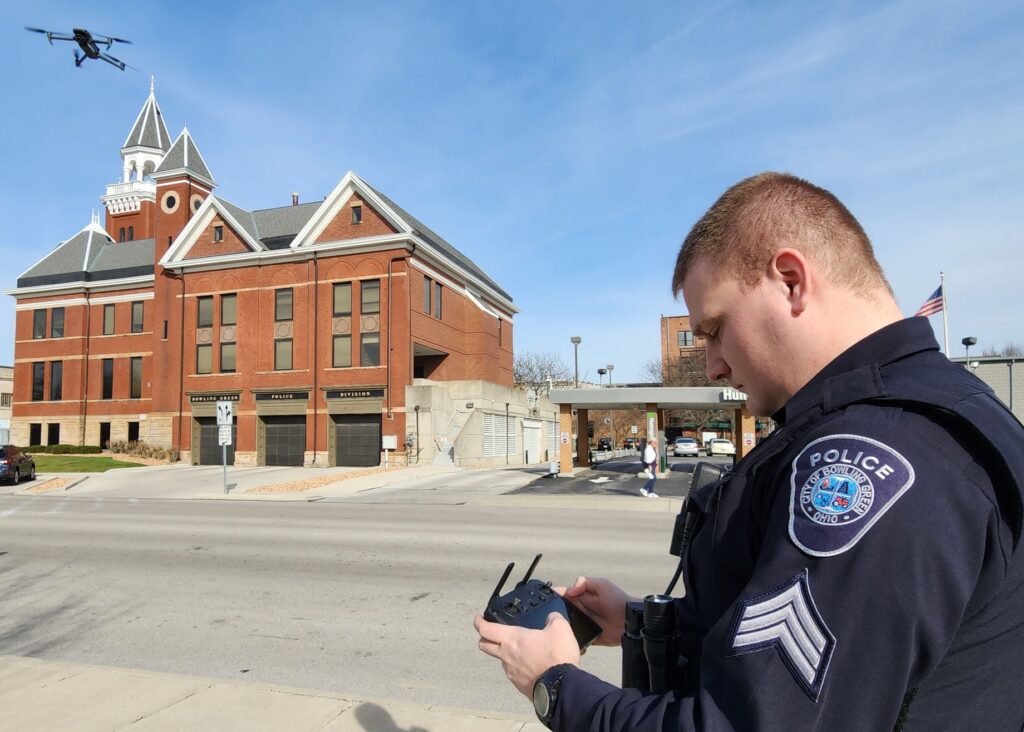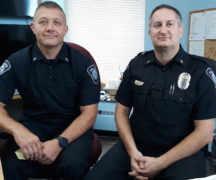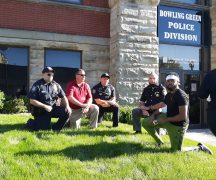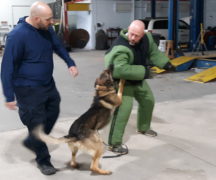By JAN McLAUGHLIN
BG Independent News
Bowling Green Police Division now has an extra pair of eyes intended to keep the city safe.
The police division has purchased two new drones, which will replace the antiquated drone that had been forfeited to the city several years ago. The new drones cost about $7,000 each, with one purchased with a grant from the Bowling Green Community Foundation, and the other with funds from the police budget.
So far, the new eyes in the sky have been dispatched to help find an aggressive loose dog, search for a man reportedly crawling outside apartment windows, check out a report of shots fired, and watch the back door as officers entered the front door of a home where a woman reported hearing an intruder inside.
The drones are expected to be used by police in cases of missing children or adults, to search for a suspect being pursued, for outdoor crime scene documentation, for surveillance in long-term investigations, or to get the lay of the land prior to serving a search warrant, said BGPD Lt. Adam Skaff.
While Google Maps are helpful, they often aren’t up to date, Skaff said.
“This will allow for pre-planning of some operations,” he said. “It gives us the ability to have another pair of eyes.”
The drones will only be deployed in situations outlined in police policies and procedures – during emergency situations or for pre-planning of events.
“The police division doesn’t want to spy on anyone,” Skaff said. “We respect people’s privacy.”
The fire division is supportive of the drone program, noting that the thermal cameras can identify lingering hot spots after structure fires or after fireworks. And the organizers of the Black Swamp Arts Festival penned a letter of support, saying the drones can help identify possible problems during the event, and help with better planning in the future.
Three police division staff have been trained and tested in drone deployment, including Chief Tony Hetrick, who is a pilot, and a sergeant and patrol officer. Only authorized personnel, who must take a certification test every two years, can deploy the drones.
The new drones are much more useful than older models, with better battery life for up to 45 minutes of flight time (with four batteries it has a total of three hours of flight), thermal camera, zoom camera, a spotlight, and a speaker to communicate with people on the ground.
The drone sends its view to the controls held by its operator, who can direct it to snap photos or record video. The equipment can fly up to 400 feet, and safely operate in temperatures of 14 to 104 degrees.
“It has the ability to do a lot of things the current one can’t do,” Skaff said.

On Tuesday, one of the drone operators, Sgt. Ryan Sehlhorst demonstrated the quick deployment of the drone and its ability to read the words on the sculpture in Wooster Green as it hovered 300 feet above. It also notified Sehlhorst of the jet flying far overhead.
The control screen glowed as the thermal camera registered heat from Sehlhorst below.
“There’s a lot we can do with this,” he said, stressing that the drones will only be used in emergency situations, and will only record video if necessary.
Such equipment could help with situations like the workplace shooting last year, when the suspect holed up in his apartment. With a drone, the police would be able to survey the location and identify hiding places.
Skaff described how the drones could be used to survey an area if city residents call to report someone breaking into cars.
“The suspect can see us,” when patrol cars arrive on the scene, he said. “But they can’t hide from the thermal cameras.”
“This is something we aren’t using every day,” Skaff said. “But it’s another tool on our belt.”





